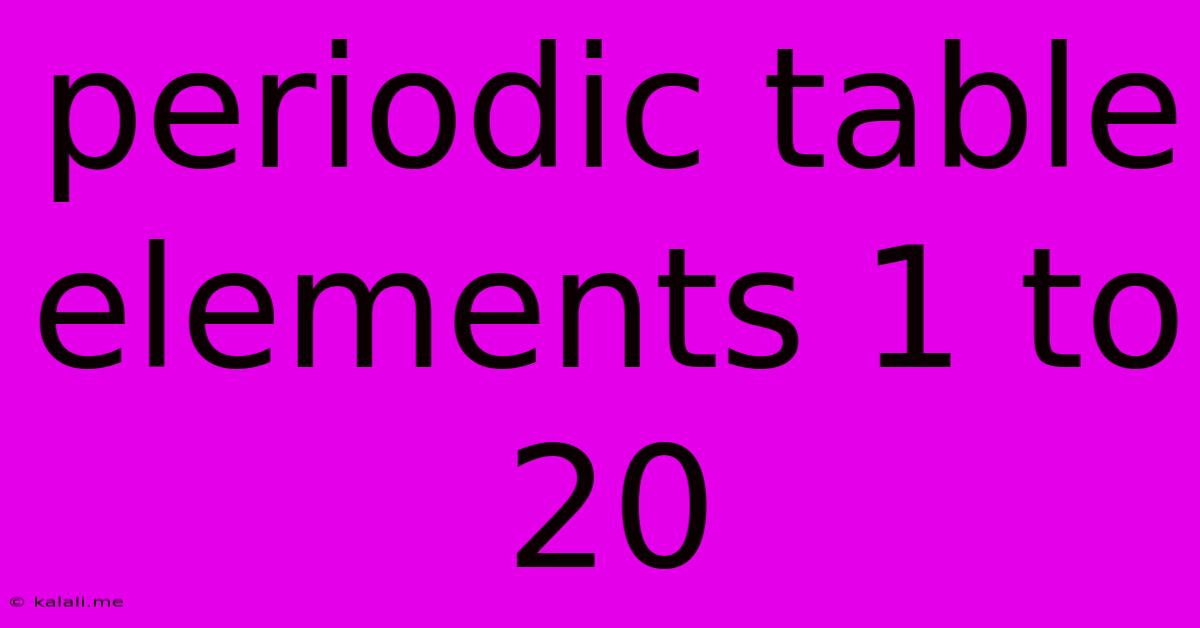Periodic Table Elements 1 To 20
Kalali
Jun 16, 2025 · 3 min read

Table of Contents
Unveiling the First 20 Elements: A Journey Through the Periodic Table
The periodic table, a cornerstone of chemistry, organizes elements based on their atomic structure and properties. Understanding the first 20 elements provides a fundamental grasp of chemical behavior and lays the groundwork for exploring more complex compounds and reactions. This article delves into the fascinating characteristics of elements 1 through 20, highlighting their key features, uses, and significance.
A Quick Glance at the First 20 Elements
Elements 1-20 encompass a diverse range of properties, transitioning from reactive gases to strong, durable metals. This journey through the periodic table introduces us to the building blocks of much of the matter we encounter daily. We'll explore their atomic structures, chemical behaviors, and practical applications, helping you to build a strong foundation in chemistry.
The First 10: Light Elements and Their Importance
The first ten elements are relatively light and abundant in the universe. Let's explore them individually:
- Hydrogen (H): The most abundant element in the universe, essential for water and many organic compounds. It's used as a fuel and in the production of ammonia.
- Helium (He): An inert noble gas, known for its low density and use in balloons, cryogenics, and MRI machines.
- Lithium (Li): An alkali metal used in batteries, ceramics, and lubricating greases. It's also used in certain psychiatric medications.
- Beryllium (Be): A lightweight, strong metal used in aerospace applications and nuclear reactors. However, it's toxic.
- Boron (B): A metalloid crucial in plant growth and used in various materials, including glass and detergents.
- Carbon (C): The backbone of organic chemistry, forming the basis of life and countless compounds, including diamonds and graphite.
- Nitrogen (N): A crucial component of the atmosphere and a key nutrient for plant growth. It's used in fertilizers and the production of ammonia.
- Oxygen (O): Essential for respiration and combustion, oxygen is a highly reactive gas vital for life.
- Fluorine (F): A highly reactive halogen used in dental products and various industrial processes. It's also crucial in refrigerants (though environmentally harmful ones are being phased out).
- Neon (Ne): An inert noble gas used in lighting and signage due to its bright, reddish-orange glow.
Elements 11-20: Expanding the Chemical Landscape
The next ten elements introduce us to more diverse properties and applications:
- Sodium (Na): An alkali metal crucial for biological functions and widely used in table salt (sodium chloride) and industrial processes.
- Magnesium (Mg): A lightweight, strong metal used in alloys, manufacturing, and as a dietary supplement.
- Aluminum (Al): The most abundant metal in the Earth's crust, widely used in packaging, transportation, and construction due to its lightweight and corrosion-resistant properties.
- Silicon (Si): A metalloid crucial for semiconductor technology and the production of glass and ceramics. It's also a key component of computer chips.
- Phosphorus (P): Essential for life, phosphorus is used in fertilizers and detergents. It also has applications in various industries.
- Sulfur (S): A nonmetal used in the production of sulfuric acid, a crucial industrial chemical. It is also found in many organic compounds.
- Chlorine (Cl): A halogen used in water purification, disinfectants, and the production of various chemicals.
- Argon (Ar): An inert noble gas used in welding and as a protective atmosphere in various industrial processes.
- Potassium (K): An alkali metal crucial for plant growth and many biological functions. It's used in fertilizers and other applications.
- Calcium (Ca): A vital element for bone structure and many biological processes. It's also used in construction materials, such as cement.
Conclusion: The Foundation of Chemistry
Understanding the properties and applications of the first 20 elements is crucial for anyone studying chemistry or related fields. This exploration provides a solid foundation for comprehending more complex chemical reactions and the behavior of matter. The diversity of applications, from everyday uses to high-tech industries, highlights the fundamental importance of these building blocks of the universe. Further exploration of the periodic table will build upon this foundational knowledge, revealing even more fascinating aspects of the chemical world.
Latest Posts
Latest Posts
-
How To Create Clickable Image In Html
Jun 16, 2025
-
What Are The Factors Of 121
Jun 16, 2025
-
What Is A Theme Of The Passage
Jun 16, 2025
-
A Company That Provides Access To The Internet
Jun 16, 2025
-
Which Word Is Closest In Meaning To The Underlined Word
Jun 16, 2025
Related Post
Thank you for visiting our website which covers about Periodic Table Elements 1 To 20 . We hope the information provided has been useful to you. Feel free to contact us if you have any questions or need further assistance. See you next time and don't miss to bookmark.